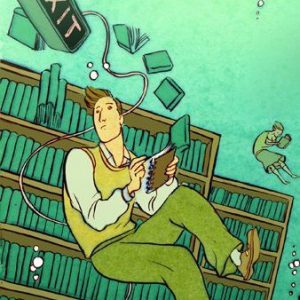Two inspiring and highly topical classes by Lyn Robinson have left my mind feeling expanded, excited and terrified! After the second class, there was a huge temptation to run home, burn all my technology, grab my favourite Terry Pratchett novel and flee to a cabin in the woods. What I am starting to grasp is that data, documents, and images, are everywhere. In my last post, I pondered romantically over the notion that data is simply a ‘sea of information’. A rookie mistake, data is much more like a vast swirling galaxy, set in the black velvet of deep space, reaching to infinity and beyond. Data is omnipresent!
Time to weigh my options:
1) Carry out the ‘cabin in the woods’ plan and live my days in blissful ignorance of technology and the inescapable data.
2) Buy a Cat.
3) Let myself be swept away with the tide, explore, read, soak up what I am learning like a sponge, and try to find the bigger picture.
Let us go for option 3… it sounds like that could be an exciting odyssey.
Swept Away with the Tide – The Big Picture in an Ocean of Images.
Before the arrival of our dear friend the internet, viewing images required much more physicality than that of our digital generation. To see one of J. M. W. Turner’s beautifully elemental paintings, you would have to traverse to a gallery or visit a library to find a book on him. Master painters were singular content creators, and in the solace of their studio this was a solitary process. Cue scene… here comes the tidal wave… meet… the Internet!
The advancement of technology and open access to the world wide web has been a sweeping tide for the contemporary art practice. Art is now part of a collaborative and multidisciplinary digital world. No longer does art have a restricted creation within its own industry. Anyone with access to technology and the internet can create and share visual content. (Arbelo, M. 2014).
It is also now possible to follow practising artists on social media, feasting your eyes on real time art and infinite content. It does not end there too, endless newsprint, television, and smartphones bombard our eyes daily with images.
What does this all mean for the Library & Information Science profession?
Firstly, we must question the boundaries of contemporary art as a document. Visual literacy explores Paintings as a document and the ways in which they contain historical, social and political context. As the Fine Art practice has expanded into conceptual, installation and performance based work, we will have to develop new ways of documenting and making art accessible in the Library.
Secondly, information literacy, copyright, and censorship have become important ethics that Library and Information professionals must be aware of.
The IFLA Code of Ethics for Librarians and other Information Workers states that “Librarians and other information workers reject the denial and restriction of access to information and ideas most particularly through censorship whether by states, governments, or religious or civil society institutions.” (IFLA. 2017).
To provide freedom of information is what every Librarian should aspire to, however, in an academic library is this truly possible? Recently in my own workplace, I encountered a group of Fashion & Textiles students who were having trouble accessing images from the Vogue Archive, within our virtual learning environment. It is not uncommon for images to hit the firewall and become censored. Unavoidably, fashion and art often explore sensitive content (also read as… nudity!). I am contractually obliged to safeguard students from sensitive material. Is the service then restricting learning if it is unable to provide uncensored access to images? The truth is I am not sure I know the answer yet. I hope further studies at CityLIS will bring clarity to my obligations as a Librarian and help me find the bigger picture in a complex ocean of images, data and ethics.
References:
Arbelo, M & Franco, J. (2014). “Towards Digital Art in Information Society”. CLCWeb Comparative Literature and Culture. Volume 16, Issue 5.
IFLA. (2017). Code of Ethics for Librarians and other Information Workers. Available at: https://www.ifla.org/publications/node/11092#colleague. (Accessed: 09 October 2017).


Excellent writing, which shows you have engaged with, and understood the content and provocations of our classes so far. I like your introduction of the phrase ‘visual literacy’ as this accompanies our exploration of art as a document very well. You have a good grasp of informational issues relating to artistic practice, including ethics. Good use of references. Well done! (I think you do deserve at least one cat).
LikeLiked by 1 person
You are right to point out that the ways we document visual and live arts will have to change in response to their immateriality. It’s worth considering how their effect on audiences and the memory audience’s hold of the experiencing of art can now be shared in the public sphere without an institution’s intervention. Libraries make published information accessible, but could they act as sites for testimony and embodied reflection ie immaterial information?
You might find this of interest:
https://hcommons.org/deposits/item/hc:13023/
LikeLiked by 1 person
Cheers Joe! It’s a really exciting time for perfomance and art, like you said, with content being shared on social media it seems the emphasis has changed to be much more about the ‘experience’ and participation. Thanks for the article too, have downloaded it and will enjoy diving in! Alex
LikeLike